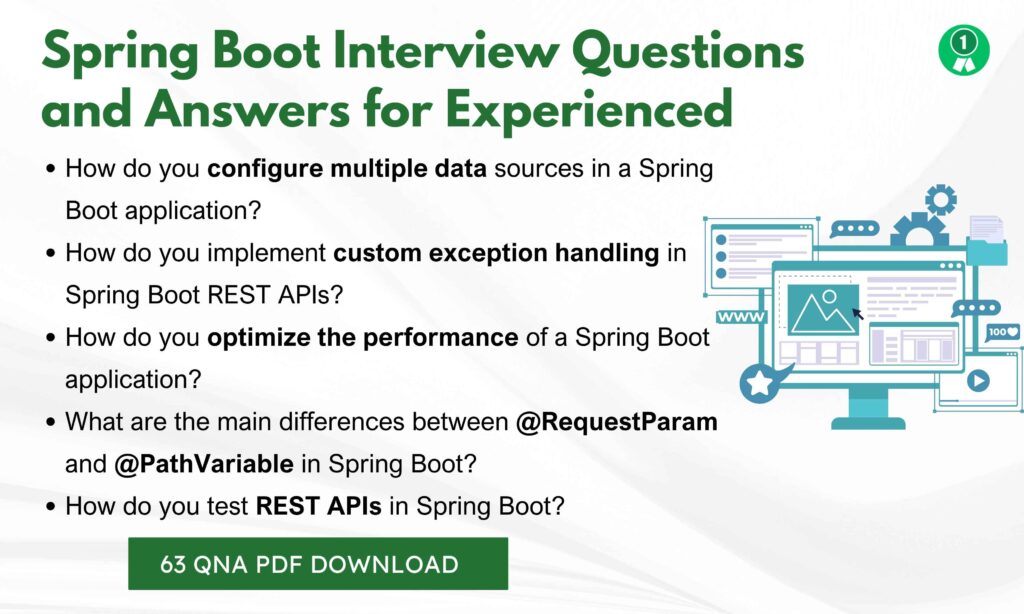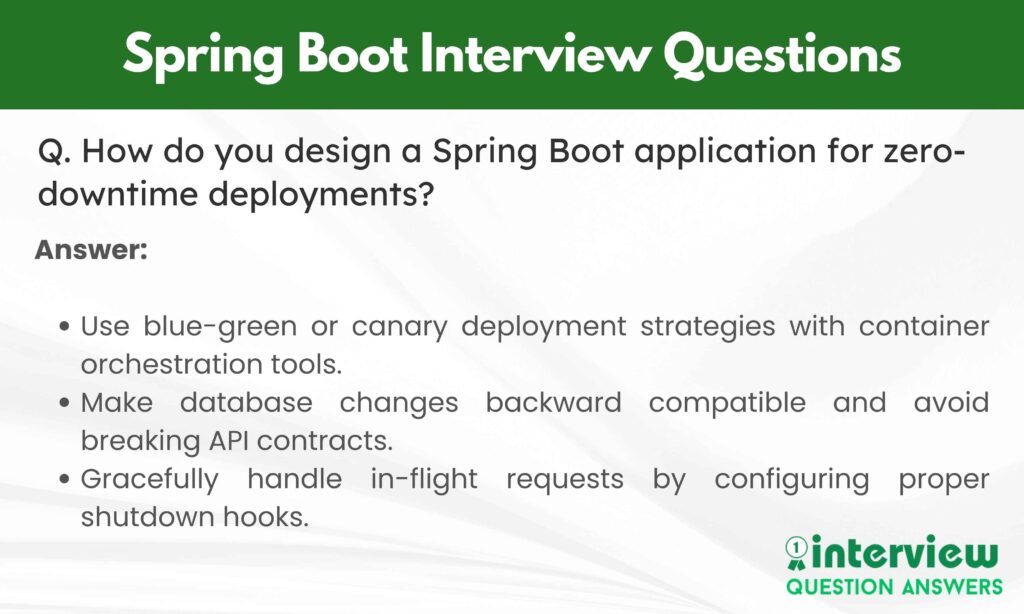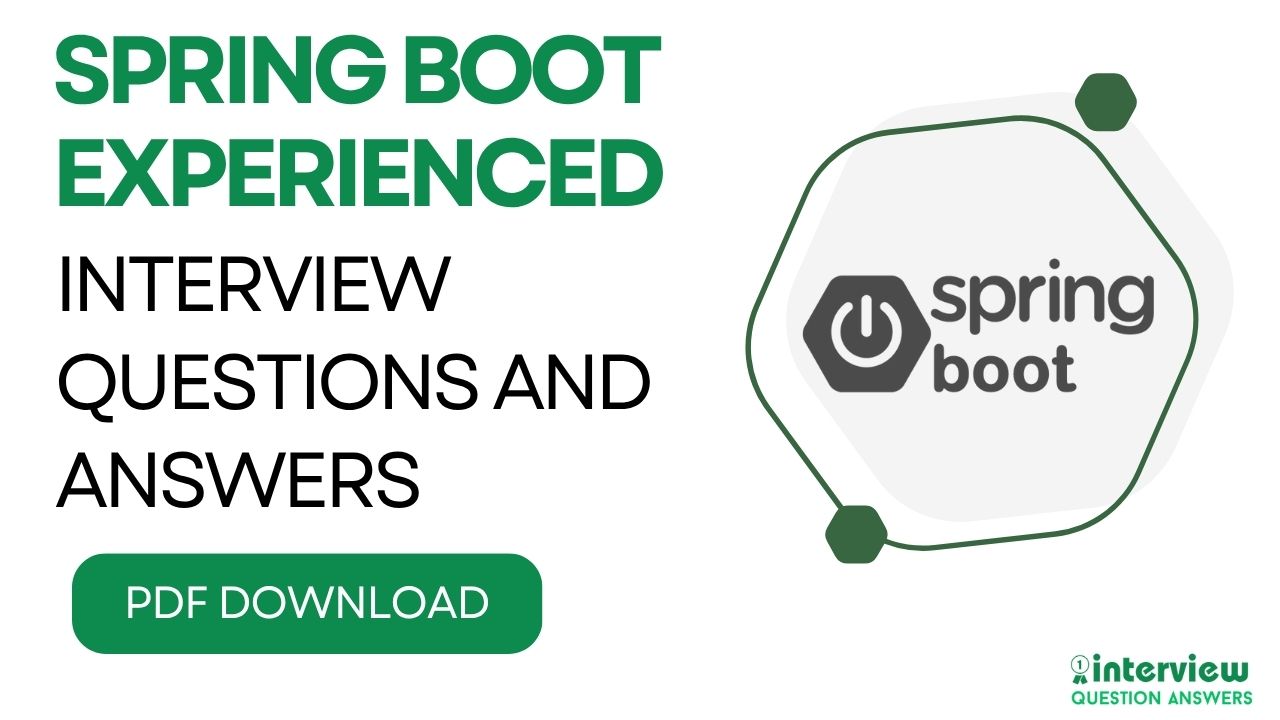Spring Boot has become the preferred choice for implementing microservices, REST APIs, and enterprise-grade systems. An experienced Spring Boot developer is expected to design robust architecture, handle real-time performance challenges, manage service orchestration, and ensure production-grade application reliability.
As organizations adopt Agile, DevOps, and cloud-native solutions, the demand for experienced Spring Boot professionals continues to rise. Employers are not only looking for developers who can write clean code but also for engineers who understand application lifecycle management, Spring Security, caching, actuator monitoring, and integrating Spring Boot with tools like Kafka, Docker, and Kubernetes.
Here we have added most asked Spring Boot Interview Questions for Experienced Professionals, focusing on practical scenarios, architectural decisions, and real-world challenges.
We have already published 100 Spring Boot Interview Questions and Answers PDF, you can check it out.
Table of Contents
Spring Boot Interview Questions and Answers for 3 Years Experienced
Que 1. How do you configure multiple data sources in a Spring Boot application?
Answer:
To configure multiple data sources:
- Define separate DataSource beans with different properties in application.yml or application.properties.
- Create a LocalContainerEntityManagerFactoryBean and PlatformTransactionManager for each data source.
- Use @Primary annotation for the default data source and configure packages with @EnableJpaRepositories for each.
Que 2. How can you handle circular dependencies in Spring Boot?
Answer:
- Use constructor injection wherever possible; circular dependencies typically arise with field or setter injection.
- If unavoidable, apply @Lazy on one of the dependencies to delay its initialization.
- Reconsider the design and split tightly coupled components into more loosely coupled services.
Que 3. How do you implement custom exception handling in Spring Boot REST APIs?
Answer:
- Create a @ControllerAdvice class with @ExceptionHandler methods for specific exceptions.
- Use ResponseEntityExceptionHandler as a base class to leverage default exception handling.
- Return structured error responses with proper HTTP status codes.
Que 4. How can you secure REST endpoints using Spring Security and JWT?
Answer:
- Configure a OncePerRequestFilter to validate JWT tokens from incoming requests.
- Store user details in SecurityContextHolder after token validation.
- Use HttpSecurity configuration in a WebSecurityConfigurerAdapter (or its modern replacement) to restrict access based on roles.
Que 5. How do you optimize the performance of a Spring Boot application?
Answer:
- Enable caching using Spring Cache with providers like Redis or EhCache.
- Optimize database queries using pagination and indexing.
- Use asynchronous processing with @Async for non-blocking tasks.
- Profile the application with tools like Spring Boot Actuator, JVisualVM, or Micrometer.
Que 6. What are the main differences between @RequestParam and @PathVariable in Spring Boot?
Answer: Both annotations are used to extract data from the URL, but they are used differently.
| Feature | @RequestParam | @PathVariable |
|---|---|---|
| Purpose | Extracts query parameters from the URL | Extracts values from URI path segments |
| URL Structure | http://localhost:8080/users?id=5 | http://localhost:8080?id=5 |
| Example Usage | public String getUser(@RequestParam int id) | public String getUser(@PathVariable int id) |
| Flexibility | Can have default values and optional parameters | Tightly bound to the URI structure |
@RequestParam is ideal for optional parameters or filters, while @PathVariable is better for resource identifiers that are part of the URL path.
Que 7. How do you test REST APIs in Spring Boot?
Answer:
- Use @WebMvcTest for controller-level testing and MockMvc for request simulation.
- For integration tests, use @SpringBootTest and TestRestTemplate or WebTestClient.
- Mock external dependencies with Mockito or WireMock for isolated testing.
Que 8. How do you implement pagination and sorting in Spring Data JPA?
Answer:
- Use the Pageable interface in repository methods, e.g., findAll(Pageable pageable).
- Create a PageRequest object with page number, size, and Sort information.
- Return Page from repository methods to access total elements and pages.
Que 9. How do you configure global CORS settings in Spring Boot?
Answer:
- Override addCorsMappings method in a WebMvcConfigurer bean to define global rules.
- Alternatively, configure spring.web.cors in application properties.
- For finer control, use @CrossOrigin at controller or method level.
Que 10. How do you enable HTTPS in a Spring Boot application?
Answer:
- Generate an SSL certificate (e.g., with keytool).
- Configure server.ssl properties in application.properties with keystore path and password.
- Ensure the server.port is set to 443 or another secure port.
Que 11. How do you implement custom health indicators with Spring Boot Actuator?
Answer:
- Create a class that implements HealthIndicator and override the health method.
- Return Health.up() or Health.down() based on custom checks (e.g., external service availability).
- The custom health indicator will appear in the /actuator/health endpoint.
Que 12. How do you handle large file uploads in Spring Boot?
Answer:
- Set multipart.max-file-size and multipart.max-request-size in application.properties.
- Use MultipartFile in controllers for receiving uploads.
- For large files, process asynchronously or store temporarily on disk to avoid memory issues.
Que 13. How do you schedule tasks in Spring Boot?
Answer:
- Enable scheduling with @EnableScheduling in a configuration class.
- Annotate methods with @Scheduled and specify cron expressions or fixed delays.
- For dynamic scheduling, use TaskScheduler beans to programmatically schedule tasks.
Que 14. How do you implement caching using Spring Boot?
Answer:
- Add @EnableCaching in the configuration class.
- Annotate methods with @Cacheable, @CachePut, or @CacheEvict to manage cache entries.
- Use cache managers like ConcurrentMapCacheManager, RedisCacheManager, or EhCache.
Que 15. How do you integrate Spring Boot with Kafka for messaging?
Answer:
- Include spring-kafka dependency and configure bootstrap servers in application.properties.
- Use @KafkaListener to consume messages and KafkaTemplate to produce messages.
- Ensure proper error handling and retry logic using SeekToCurrentErrorHandler or custom strategies.
Que 16. How do you externalize configuration in Spring Boot applications?
Answer:
- Use application.properties or application.yml for simple configurations.
- For advanced scenarios, use Spring Cloud Config Server or HashiCorp Vault.
- Environment variables and command-line arguments can also override default values.
Que 17. How do you monitor a Spring Boot application in production?
Answer:
- Enable Actuator endpoints for health, metrics, and traces.
- Integrate with Micrometer for Prometheus, Datadog, or other monitoring systems.
- Use distributed tracing tools like Zipkin or Jaeger for request correlation.
Que 18. How do you handle database migrations in Spring Boot?
Answer:
- Use Flyway or Liquibase for version-controlled database schema changes.
- Place migration scripts in db/migration (for Flyway) or specify the path in configuration.
- Run migrations automatically at startup or manually using migration commands.
Que 19. How do you improve startup time in a Spring Boot application?
Answer:
- Enable lazy initialization with spring.main.lazy-initialization=true.
- Remove unused auto-configurations by using spring.factories exclusions.
- Profile classpath scanning and dependency initialization to reduce overhead.
Que 20. How do you use interceptors in Spring Boot?
Answer:
- Implement HandlerInterceptor and override preHandle, postHandle, and afterCompletion methods.
- Register the interceptor in a WebMvcConfigurer using addInterceptors.
- Interceptors are commonly used for logging, authentication, and request modification.

Also Check: Rest API Interview Questions and Answers
Spring Boot Interview Questions for 5 Years Experienced
Que 21. How do you design a Spring Boot application for high availability and scalability?
Answer:
- Deploy the application in a stateless manner so instances can scale horizontally.
- Use external session management (e.g., Redis) if session state is required.
- Leverage cloud-native platforms like Kubernetes for automatic scaling and load balancing.
- Implement connection pooling for databases and configure appropriate resource limits.
Que 22. How do you fine-tune Hibernate performance in a Spring Boot application?
Answer:
- Enable second-level caching with providers like EhCache or Hazelcast.
- Use batch fetching or join fetching to minimize the number of queries.
- Avoid the N+1 select problem by configuring fetch joins in queries.
- Use pagination for large datasets and monitor query execution with logs.
Que 23. How do you handle distributed transactions in microservices built with Spring Boot?
Answer:
- Implement Saga patterns (choreography or orchestration) for eventual consistency.
- Use frameworks like Spring Cloud Data Flow or Axon for orchestration.
- For smaller cases, use transaction outbox patterns and reliable event publishing.
Que 24. How do you integrate Spring Boot with OAuth2 for enterprise-grade security?
Answer:
- Use Spring Security’s OAuth2 Client and Resource Server modules.
- Configure JWT token validation with a trusted authorization server like Keycloak or Okta.
- Apply role-based access control (RBAC) using GrantedAuthorities and method-level security with @PreAuthorize.
Que 25. How do you optimize thread management in a Spring Boot application?
Answer:
- Use @Async for asynchronous tasks and configure a ThreadPoolTaskExecutor with appropriate core and max pool sizes.
- Monitor thread pools using Actuator metrics to avoid starvation.
- Leverage reactive programming with Project Reactor for high-concurrency workloads.
Que 26. What strategies do you use to manage inter-service communication failures in Spring Boot microservices?
Answer: In distributed systems, communication failures are common. Spring Boot provides tools and patterns to handle these gracefully.
| Strategy | Description |
|---|---|
| Circuit Breaker | Use Resilience4j or Spring Cloud Circuit Breaker to stop cascading failures |
| Retry Mechanisms | Automatically retry failed calls with a configurable backoff strategy |
| Fallback Methods | Define alternative responses when services are unavailable |
| Timeout Settings | Set connection and read timeouts for HTTP clients like RestTemplate or WebClient |
Example using Resilience4j:
@CircuitBreaker(name = "inventoryService", fallbackMethod = "fallbackInventory")
public Inventory getInventory(String productId) {
return restTemplate.getForObject("/inventory/" + productId, Inventory.class);
}
public Inventory fallbackInventory(String productId, Throwable t) {
return new Inventory(productId, 0);
}These strategies ensure system stability even when dependent services are down.
Que 27. How do you secure sensitive configuration properties in Spring Boot?
Answer:
- Use Spring Cloud Config with encryption support or HashiCorp Vault for secure property management.
- Avoid committing secrets to source control and use environment variables for sensitive values.
- Integrate with cloud providers’ secret managers like AWS Secrets Manager or Azure Key Vault.
Que 28. How do you enable and manage distributed caching in Spring Boot?
Answer:
- Integrate with caching solutions like Redis or Hazelcast using CacheManager.
- Annotate methods with @Cacheable, @CacheEvict, and @CachePut to manage cache lifecycle.
- Implement cache invalidation strategies to ensure data consistency across services.
Que 29. How do you build a reactive application with Spring Boot and WebFlux?
Answer:
- Use Spring WebFlux with Reactor-based Mono and Flux types for reactive endpoints.
- Employ reactive drivers for databases and external APIs (e.g., R2DBC, WebClient).
- Leverage backpressure strategies to handle large amounts of data efficiently.
Que 30. How do you handle application configuration in multi-tenant environments?
Answer:
- Use tenant-specific property files or databases for configuration values.
- Apply interceptors to determine the tenant context from requests.
- Configure separate data sources dynamically or use Hibernate’s multi-tenancy support.
Que 31. How do you diagnose memory leaks in a Spring Boot application?
Answer:
- Use tools like JVisualVM, Eclipse MAT, or YourKit to analyze heap dumps.
- Check for bean lifecycle mismanagement or improper caching mechanisms.
- Monitor application memory usage via Actuator metrics and introduce resource cleanup in beans.
Que 32. How do you implement advanced scheduling in Spring Boot?
Answer:
- Use @EnableScheduling and @Scheduled for periodic tasks.
- For more dynamic scheduling, integrate with Quartz Scheduler.
- Ensure tasks are idempotent and can run in a clustered environment without duplication.
Que 33. How do you manage API versioning in Spring Boot?
Answer:
- Use URI-based versioning (e.g., /v1/resource) or request parameter headers for version control.
- Maintain backward compatibility by running multiple versions simultaneously.
- Automate API deprecation notices with Spring HATEOAS.
Que 34. How do you leverage Spring Cloud components with Spring Boot for distributed systems?
Answer:
- Use Eureka or Consul for service discovery and Ribbon or Spring Cloud LoadBalancer for client-side load balancing.
- Apply Spring Cloud Gateway for routing and API gateway requirements.
- Use Spring Cloud Config for centralized configuration and Spring Cloud Bus for distributed refresh.
Que 35. How do you debug startup failures in Spring Boot?
Answer:
- Enable debug logging with –debug flag or logging.level.root=DEBUG.
- Check bean initialization failures in logs and resolve circular dependencies or missing beans.
- Use Spring Boot’s FailureAnalyzer implementations to interpret error messages.
Que 36. How do you ensure database connection pool stability in production?
Answer:
- Tune HikariCP settings like maximumPoolSize and connectionTimeout according to load.
- Validate connections with connectionTestQuery or built-in validation.
- Monitor pool metrics via Actuator and integrate alerts for pool exhaustion.
Que 37. How do you deploy a Spring Boot application in a containerized environment?
Answer:
- Create a Dockerfile using a lightweight base image (e.g., Alpine) and JAR packaging.
- Use multi-stage builds to reduce image size.
- Deploy to container orchestration systems like Kubernetes and configure resource limits.
Que 38. How do you handle internationalization (i18n) in Spring Boot?
Answer:
- Add message property files (messages_en.properties, messages_fr.properties, etc.) for different locales.
- Configure a LocaleResolver bean and use Accept-Language header to switch languages.
- Use MessageSource to fetch localized messages in code.
Que 39. How do you manage large file downloads efficiently in Spring Boot?
Answer:
- Use StreamingResponseBody to stream files without loading them entirely into memory.
- Set proper Content-Type and Content-Disposition headers for browser downloads.
- For cloud storage, directly return signed URLs instead of proxying large files.
Que 40. How do you integrate Spring Boot with external monitoring solutions?
Answer:
- Expose metrics with Spring Boot Actuator and integrate with Prometheus, Graphite, or Datadog.
- Enable distributed tracing with Sleuth and connect to Zipkin or Jaeger.
- Use health checks and custom endpoints for infrastructure-level monitoring tools.
Also Check: Microservices Interview Questions for Experienced Professional
Spring Boot Interview Questions for 10 Years Experienced
Que 41. How do you architect a large-scale Spring Boot application for modularity and maintainability?
Answer:
- Break the application into independent modules or services using Domain-Driven Design (DDD).
- Use Maven or Gradle multi-module setups for separation of concerns.
- Apply dependency inversion and leverage Spring Boot starters for common features.
- Enforce strict API contracts using REST, GraphQL, or messaging between modules.
Que 42. How do you manage complex configurations across multiple environments in Spring Boot?
Answer:
- Use Spring Cloud Config Server for centralized configuration management.
- Apply profiles (application-dev.yml, application-prod.yml) and environment variables for environment-specific properties.
- Integrate with secret managers (Vault, AWS Secrets Manager) to handle sensitive data.
Que 43. How do you design a Spring Boot application to be fully cloud-native?
Answer:
- Use 12-factor app principles including externalized configurations, stateless processes, and disposability.
- Implement health checks and liveness probes for orchestration tools like Kubernetes.
- Leverage Spring Cloud features like service discovery, API gateways, and circuit breakers.
Que 44. How do you ensure data consistency in distributed Spring Boot applications?
Answer:
- Implement eventual consistency using the Saga pattern for multi-service transactions.
- Use outbox patterns to avoid dual-write problems when persisting events and data.
- Design idempotent consumers for handling retries without duplicate effects.
Que 45. How do you optimize garbage collection in high-traffic Spring Boot applications?
Answer:
- Choose a suitable GC algorithm like G1 or ZGC based on latency requirements.
- Tune heap sizes and GC thresholds with JVM flags.
- Monitor GC metrics via Spring Boot Actuator and tools like JVisualVM to avoid frequent full GCs.
Que 46. How do you handle distributed transaction management across multiple microservices in Spring Boot?
Answer: Distributed transactions are challenging in microservices because each service typically maintains its own database. Instead of traditional two-phase commits, event-driven approaches and sagas are used.
| Approach | Description |
|---|---|
| Saga Pattern | Break the transaction into a series of local transactions with compensating actions |
| Event-Driven Choreography | Services publish and listen to events to maintain data consistency |
| Orchestration | A central orchestrator service coordinates the entire transaction workflow |
Example using the Saga pattern with orchestration:
- Service A updates its data and sends an event.
- Orchestrator listens to the event and triggers Service B.
- If Service B fails, orchestrator triggers a compensating transaction in Service A.
This ensures data consistency without blocking services or tightly coupling databases.
Que 47. How do you secure large enterprise Spring Boot applications at scale?
Answer:
- Implement centralized authentication using OAuth2/OpenID Connect providers like Okta or Keycloak.
- Use API gateways for enforcing security policies and rate-limiting.
- Apply encryption for sensitive data at rest and in transit and audit access using Spring Security’s audit features.
Que 48. How do you debug performance bottlenecks in production Spring Boot applications?
Answer:
- Profile applications using tools like JProfiler, YourKit, or Flight Recorder.
- Leverage Actuator metrics and distributed tracing (Sleuth, Zipkin) to find slow services or queries.
- Analyze thread dumps and heap dumps during spikes for resource contention issues.
Que 49. How do you design APIs in Spring Boot to handle backward compatibility?
Answer:
- Implement API versioning via URI paths, query parameters, or headers.
- Use feature toggles to gradually roll out or deprecate features.
- Maintain clear API documentation with tools like Spring REST Docs or OpenAPI.
Que 50. How do you handle schema evolution in complex Spring Boot projects?
Answer:
- Automate schema changes using Flyway or Liquibase and ensure backward-compatible migrations.
- Use blue-green or rolling deployments to avoid downtime during migrations.
- Implement database versioning validation at application startup.
Que 51. How do you scale Spring Boot applications horizontally without session loss?
Answer:
- Store session data in external caches like Redis using Spring Session.
- Ensure stateless service design whenever possible.
- Use sticky sessions in load balancers only if absolutely necessary.
Que 52. How do you implement advanced logging and observability for Spring Boot applications?
Answer:
- Use structured logging with Logback or Log4j2 and integrate with ELK or Splunk.
- Employ correlation IDs for tracing requests across distributed services.
- Combine logs, metrics, and traces with observability platforms like OpenTelemetry.
Que 53. How do you integrate GraphQL into a Spring Boot application?
Answer:
- Use Spring for GraphQL or libraries like graphql-java.
- Define schema-first APIs and map resolvers to service methods.
- Optimize performance with data loaders to batch requests and avoid N+1 problems.
Que 54. How do you handle concurrency challenges in Spring Boot services?
Answer:
- Use optimistic or pessimistic locking for shared database entities.
- Employ distributed locks using Redis or Zookeeper for multi-node environments.
- Avoid shared mutable state and use @Async with properly configured thread pools.
Que 55. How do you manage large batch processing jobs in Spring Boot?
Answer:
- Use Spring Batch for chunk-based or tasklet-based job execution.
- Scale batch jobs using partitioning or remote chunking strategies.
- Monitor job execution with Spring Batch Admin or custom dashboards.
Que 56. How do you reduce startup time for large Spring Boot applications?
Answer:
- Enable lazy initialization of beans with spring.main.lazy-initialization=true.
- Remove unused auto-configurations via spring.factories exclusions.
- Leverage AOT compilation or GraalVM native images if applicable.
Que 57. How do you implement multi-tenancy in Spring Boot with high data isolation?
Answer:
- Use database-per-tenant or schema-per-tenant strategies with a custom DataSource routing implementation.
- Resolve tenant context using request interceptors.
- Ensure tenant-based data isolation is enforced at repository and service layers.
Que 58. How do you enforce governance and standards across multiple Spring Boot teams?
Answer:
- Provide internal Spring Boot starters with standardized configurations.
- Implement static analysis tools (SonarQube, Checkstyle) for code quality.
- Use CI/CD templates to enforce security, testing, and deployment pipelines.
Que 59. How do you implement event-driven architecture in Spring Boot?
Answer:
- Use Spring Cloud Stream for connecting to messaging platforms like Kafka or RabbitMQ.
- Apply event sourcing for maintaining state changes as a series of events.
- Design durable, replayable event logs to enable reliable processing.
Que 60. How do you support hybrid on-premise and cloud deployments for Spring Boot applications?
Answer:
- Externalize configurations and use property sources suited to each environment.
- Use containerization and orchestration platforms that run on both on-prem and cloud.
- Implement cloud-agnostic APIs or use Spring Cloud’s abstraction for services.
Que 61. How do you secure Spring Boot applications against advanced threats like CSRF and XSS?
Answer:
- Enable CSRF protection in Spring Security where necessary (e.g., non-REST APIs).
- Validate and sanitize input data to prevent XSS and injection attacks.
- Regularly patch dependencies and use dependency-check tools to avoid known vulnerabilities.
Que 62. Can you explain the concept of dependency injection in Spring Boot and why it is beneficial?
Answer:
Dependency Injection (DI) in Spring Boot is a design pattern where objects receive other objects they depend on, called dependencies, from an external source rather than creating them internally. This principle fosters loose coupling and enhances code maintainability and testability.
In Spring Boot, DI is primarily achieved through constructor, setter, or field injections, managed by the Spring IoC (Inversion of Control) container. It promotes modularity, simplifies unit testing, and improves code reusability. By externalizing the management of dependencies, Spring Boot applications become more flexible and easier to manage.
Que 63. How do you design a Spring Boot application for zero-downtime deployments?
Answer:
- Use blue-green or canary deployment strategies with container orchestration tools.
- Make database changes backward compatible and avoid breaking API contracts.
- Gracefully handle in-flight requests by configuring proper shutdown hooks.

Also Check: Java OOPs Interview Questions and Answers
Spring Boot Interview Questions for Experienced PDF
We have added above questions to a PDF, that you can download and practice interview questions anytime offline.
FAQs: Spring Boot Interview Questions for Experienced
What is the role of professionals who answer Spring Boot Interview Questions?
Professionals expected to answer Spring Boot interview questions typically work as backend developers, software engineers, or solution architects. They specialize in designing, developing, and maintaining enterprise-level applications using Spring Boot, often focusing on scalability, security, and integration with cloud services.
What challenges might candidates face during Spring Boot interviews?
Candidates often face challenges in demonstrating real-world problem-solving, particularly with complex configurations, microservices architecture, and performance optimization. They may also need to show deep knowledge of Spring Security, data management, and distributed system design, which can be tested with scenario-based questions.
What challenges might professionals face in a Spring Boot job role?
In the workplace, professionals may encounter challenges such as managing high-traffic systems, integrating with third-party APIs, handling legacy code migration, and maintaining security in distributed environments. Ensuring applications remain performant while adding new features is another common challenge.
What is the average salary for Spring Boot professionals in the USA?
The average salary for a Spring Boot developer in the USA ranges from $110,000 to $140,000 annually. Senior developers or architects with experience in cloud-native systems, microservices, and advanced security can earn upwards of $150,000 to $170,000 per year.
Which top companies hire professionals with Spring Boot expertise?
Leading technology firms like Amazon, Google, Microsoft, IBM, and Netflix hire Spring Boot professionals. Consulting companies such as Accenture, Deloitte, and Capgemini also actively recruit skilled Spring Boot developers for enterprise solutions.
How important is microservices experience for Spring Boot job roles?
Microservices experience is highly valuable because many organizations use Spring Boot to build distributed applications. Candidates with hands-on microservices architecture knowledge, including service discovery, API gateways, and inter-service communication, are preferred for senior roles.
Are certifications useful for candidates preparing for Spring Boot interviews?
Certifications from organizations like Pivotal, Oracle, or cloud providers (AWS, Azure) can help validate a candidate’s expertise. While not mandatory, they demonstrate a strong foundation in Spring Boot and related technologies, improving credibility during the interview process.







